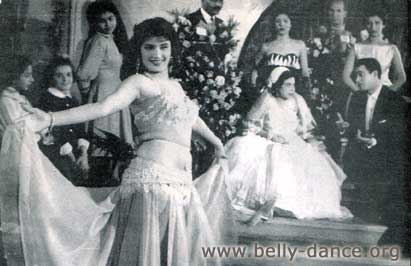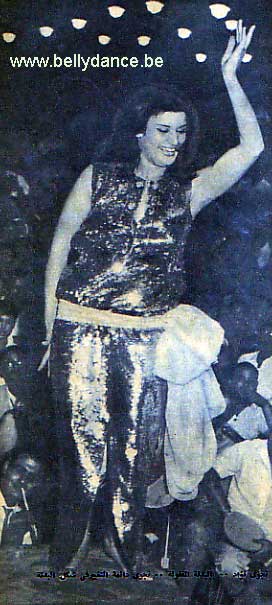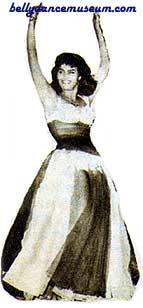- Nagua Fouad

Nagua Fouad was very popular the 70's and 80's. Nagwa's fame started to rise in the sixties. By the seventies Nagwa Fuad was the top belly-dancer in the Arab world and beyond. She was on the cover of Egyptian magazines like the one of 1966 of "Al Kawakeb" (showed on the next page). Dancing has always been her priority above anything else: "To be a dancer, a respected, famous dancer was my dream since I was about six, when I started dancing...".
Nagua Fouad was born in 1943 in Alexandria under the name Awatef. Her father was Egyptian and her mother Palestinian. Her mother died a few months after Nagua was born and her father remarried another Palestinian woman.
Later in 1958, just before becoming 15, Nagua ran away from Alexandria to Cairo without a penny. Najwa became known as dancer in 1959. She was always been very impressed by Na'ema Akef and like to follow her footsteps. Arriving in Caïro she took up a job as a telephone operator at the Orabi Agency for the stars of the Egyptian Cinema.
Her step-mom who had followed her to Cairo so now she was able to support her also. Her job at the Orabi agency was her first conscious career step to move from rags to riches. "When Orabi saw me dance, he persuaded me to rent a belly-dancer's costume for 50 piastres and hit the stage."

Not long after, Nagwa Fouad began dancing at "Sahara City", a famous night-club at the foot of the Pyramids. But "Sahara City" was perhaps more worldwide known as the title of the belly dance album it was named after. Some time later she moved to the more glamorous "Auberge des Pyramides".
The next important career step was Nagwa's marriage to Ahmed Fouad Hassan, the talented violin player, composer and conductor. Ahmed gave Nagwa Fouad her chance to appear in the very popular sixties stage show "Adwoua Al-Madina" (City Lights), which had featured such superstars as Abdel-Halim Hafez, Fayza Ahmed, Shadia and Sabah. Nagwa featured on many of the covers of the Ahmed Fouad Hassan LP's/CD's. 
Nagua took every career step well calculated: "Hassan was 17 years older than me, but I needed him. He nurtured my amateur's talents... He taught me the importance of studying and working on my talent if I wanted to be a big star. He trained me at the Nelly Mazloum Dance School and I joined the National Dance Troupe to study folklore with Russian teachers."
Nagoua Fouad learned showmanship and eye-catching techniques which were obvious in her performances of "Ayoub Al-Masri" and "Bahiya wa Yassin". But Fouad Hassan wanted to have a baby with Nagua. Something she didn't approve to so this eventually led to her first divorce after six years of marriage.
In 1976, Nagwa Fouad reached the top of her career when composer Mohamed Abdel-Wahab wrote "Qamar Arbaa-tashar" (Blue Moon or 14the moon) for her. Her stage performance to this special piece allowed her to change the way belly-dancing was presented on stage, transforming it from traditional oriental dance to more of a choreographed lavish spectacle adding more dramatic elements to it than ever before. The composition served as a transition for Nagwa: "I was able to combine the oriental dancing of Tahiya Karioka and Samia Gamal with Na'ema's acrobatic style and created a stage show like a dramatic piece" she says. Najwa established her own dance group but it did not last long and later tried to retire dancing to become actress. She played on the stage and in the cinema and finally became cinema producer.
